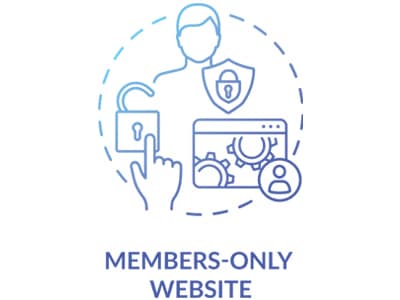
Your website is the global display case for you and your brand. How can you make it work for you? There are several outlets you should explore when considering how your website can make money.
Network or Affiliate Marketing
Affiliate marketing is a method of earning a commission based on referring your readers or viewers to an affiliate program or service. Compensation is commonly per referral and only when a purchase is made.
Typically, you’re given a unique link or discount code (thus the incentive for your audience to go through you) and this is how your compensation is tracked. Get to know your industry partners and build working relationships with them. This method works best with services or products you actually use.
Paywall or Memberships

The internet is packed with free information, which makes this method of monetization more difficult. However, the right people will pay for exclusive content or access. You’ll need to develop your unique metric for magnetizing folks to your offer.
If you have an established audience who already follows and believes in the content you offer, you’re on your way to succeeding with this method. If you don’t have an established following, it’s time to start growing one. Continue offering some of your content for free but also offer an upgrade option with exclusive material.
Patreon and Twitch accounts are easy ways to implement a membership circle. You can also take payment yourself and set up a private social media group for an even more affordable option.
Ads
No one truly enjoys a pop-up, static, or banner ad. But they get the job done!
You can install programs like Google’s AdSense for context-based advertising. This will show your visitors ads that are relevant to them and allows you to customize or block what doesn’t suit your brand. The commissions are paid out as “cost-per-click”, the amount you earn each time a user clicks on your ad.
Placing Amazon Associates ads on your site works a bit like affiliate marketing where you’re recommending specific products. Chefs may link to kitchen gadgets, while a vlogger may share their video recording equipment.
Use caution when setting up ads on your website to avoid overwhelming or irritating your visitors. Consider skipping this feature altogether if you’re running a product or eCommerce website, as the purpose of the ad is to encourage folks to leave and buy something else.
Sell Products

Occasionally, we have great ideas. Less often, we put those ideas to work. When selling products, make sure you’re sticking to what defines your brand and what you know. Every aspect of your brand must align with what your customer knows about you, otherwise, they’ll be less inclined to buy.
Popular types of products to sell include:
Digital
The possibilities are endless and endlessly repeatable when it comes to digital assets. Because you make them once and can sell them over and over again, this becomes what is known as an “evergreen” item.
Some examples include:
- Ebooks
- Checklists
- Cheat sheets
- Templates
- Tutorial guides
- Planners and trackers
- Stock photos or graphics
- Social media content
- Audiobooks
Ask Infinite Creations Atlanta how you can sell digital products!
Physical
Selling a physical product could be as complex as inventing and manufacturing something new or as simple as taking something that’s been white-labeled and making it your own.
Manufacturing your own product is a long road but is ultimately worth the journey. Buyers love new and innovative products that aren’t already on every shelf in the neighborhood. Be prepared to pay for development, branding, packaging, marketing, inventory, etc.
If you have a phrase, graphic, or logo that you’re known for, put it to good use as branded merchandise! Teespring and StickerMule are good examples of white labeled merchandise. You can upload your unique designs and dropship custom products to your customers directly from their platforms.
Reselling retail items that fit within your brand is a step above affiliate marketing. Rather than linking to the item on another website, you become the supplier. And if you utilize a fulfillment center, you don’t even have to endure shipping or inventory.
Offer an Online Course

The digital course market is one of the hottest growing markets out there. According to Forbes, even before the pandemic, the online education market was forecasted to hit $350 Billion by 2025. That’s BILLION, with a B.
This requires you to take what you know, get it out of your head, then put it into a format that is marketable. You could produce video tutorials, workbooks, ebooks, step-by-step plans, and even add in one-on-one or group coaching for a personal element. The best courses include a combination of all these.
There are multiple platforms available that make it easy to host and organize your content in a repeatedly consumable way. Udemy and Skillshare host and feature your content on their searchable marketplace, while private platforms like Kajabi and Teachable can only be accessed by your paying customers.
BONUS TIPS
Here are a few other things to add to the list for consideration when monetizing your website.
- Ensure your website is optimized for the fastest loading times. This means pay close attention to image sizes and the number of images displayed.
- Optimize for mobile devices. This is a standard expectation these days but some developers or web themes perform better on mobile than others.
- There’s no point in monetizing your site if you have no visitors. You’ll need to develop a marketing strategy in order to drive traffic and reap the benefits of your monetization efforts. The above are only options you can try after your customer has found you.
Though there are numerous opportunities to grow your bottom line from your website, none of them are a “quick fix”. They all require hard (or costly) work and marketing that drives traffic and conversion back to you.
What is the strategy you know you can implement today? Still not sure? Get in touch with our team for a consultation.




